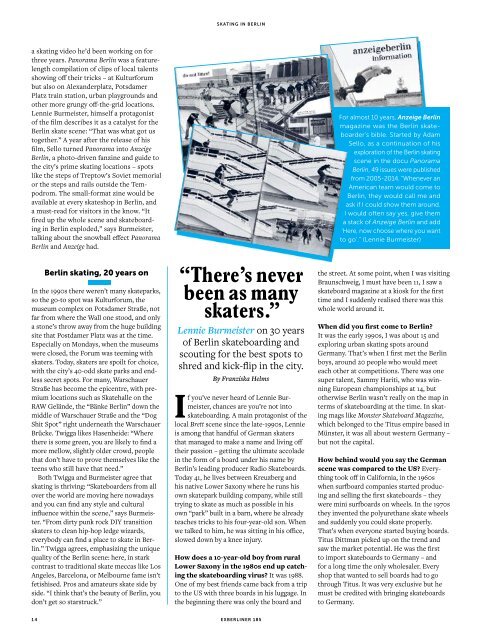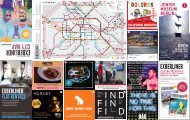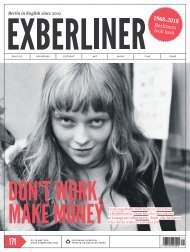Exberliner issue 185, September 2019
- No tags were found...
Create successful ePaper yourself
Turn your PDF publications into a flip-book with our unique Google optimized e-Paper software.
SKATING IN BERLIN<br />
a skating video he’d been working on for<br />
three years. Panorama Berlin was a featurelength<br />
compilation of clips of local talents<br />
showing off their tricks – at Kulturforum<br />
but also on Alexanderplatz, Potsdamer<br />
Platz train station, urban playgrounds and<br />
other more grungy off-the-grid locations.<br />
Lennie Burmeister, himself a protagonist<br />
of the film describes it as a catalyst for the<br />
Berlin skate scene: “That was what got us<br />
together.” A year after the release of his<br />
film, Sello turned Panorama into Anzeige<br />
Berlin, a photo-driven fanzine and guide to<br />
the city’s prime skating locations – spots<br />
like the steps of Treptow’s Soviet memorial<br />
or the steps and rails outside the Tempodrom.<br />
The small-format zine would be<br />
available at every skateshop in Berlin, and<br />
a must-read for visitors in the know. “It<br />
fired up the whole scene and skateboarding<br />
in Berlin exploded,” says Burmeister,<br />
talking about the snowball effect Panorama<br />
Berlin and Anzeige had.<br />
Berlin skating, 20 years on<br />
In the 1990s there weren’t many skateparks,<br />
so the go-to spot was Kulturforum, the<br />
museum complex on Potsdamer Straße, not<br />
far from where the Wall one stood, and only<br />
a stone’s throw away from the huge building<br />
site that Postdamer Platz was at the time.<br />
Especially on Mondays, when the museums<br />
were closed, the Forum was teeming with<br />
skaters. Today, skaters are spoilt for choice,<br />
with the city’s 40-odd skate parks and endless<br />
secret spots. For many, Warschauer<br />
Straße has become the epicentre, with premium<br />
locations such as Skatehalle on the<br />
RAW Gelände, the “Bänke Berlin” down the<br />
middle of Warschauer Straße and the “Dog<br />
Shit Spot” right underneath the Warschauer<br />
Brücke. Twigga likes Hasenheide: “Where<br />
there is some green, you are likely to find a<br />
more mellow, slightly older crowd, people<br />
that don’t have to prove themselves like the<br />
teens who still have that need.”<br />
Both Twigga and Burmeister agree that<br />
skating is thriving: “Skateboarders from all<br />
over the world are moving here nowadays<br />
and you can find any style and cultural<br />
influence within the scene,” says Burmeister.<br />
“From dirty punk rock DIY transition<br />
skaters to clean hip-hop ledge wizards,<br />
everybody can find a place to skate in Berlin.”<br />
Twigga agrees, emphasizing the unique<br />
quality of the Berlin scene: here, in stark<br />
contrast to traditional skate meccas like Los<br />
Angeles, Barcelona, or Melbourne fame isn’t<br />
fetishised. Pros and amateurs skate side by<br />
side. “I think that’s the beauty of Berlin, you<br />
don’t get so starstruck.”<br />
“There’s never<br />
been as many<br />
skaters.”<br />
Lennie Burmeister on 30 years<br />
of Berlin skateboarding and<br />
scouting for the best spots to<br />
shred and kick-flip in the city.<br />
By Franziska Helms<br />
If you’ve never heard of Lennie Burmeister,<br />
chances are you’re not into<br />
skateboarding. A main protagonist of the<br />
local Brett scene since the late-1990s, Lennie<br />
is among that handful of German skaters<br />
that managed to make a name and living off<br />
their passion – getting the ultimate accolade<br />
in the form of a board under his name by<br />
Berlin’s leading producer Radio Skateboards.<br />
Today 41, he lives between Kreuzberg and<br />
his native Lower Saxony where he runs his<br />
own skatepark building company, while still<br />
trying to skate as much as possible in his<br />
own “park” built in a barn, where he already<br />
teaches tricks to his four-year-old son. When<br />
we talked to him, he was sitting in his office,<br />
slowed down by a knee injury.<br />
How does a 10-year-old boy from rural<br />
Lower Saxony in the 1980s end up catching<br />
the skateboarding virus? It was 1988.<br />
One of my best friends came back from a trip<br />
to the US with three boards in his luggage. In<br />
the beginning there was only the board and<br />
For almost 10 years, Anzeige Berlin<br />
magazine was the Berlin skateboarder’s<br />
bible. Started by Adam<br />
Sello, as a continuation of his<br />
exploration of the Berlin skating<br />
scene in the docu Panorama<br />
Berlin, 49 <strong>issue</strong>s were published<br />
from 2005-2014. “Whenever an<br />
American team would come to<br />
Berlin, they would call me and<br />
ask if I could show them around.<br />
I would often say yes, give them<br />
a stack of Anzeige Berlin and add<br />
‘Here, now choose where you want<br />
to go’.” (Lennie Burmeister)<br />
the street. At some point, when I was visiting<br />
Braunschweig, I must have been 11, I saw a<br />
skateboard magazine at a kiosk for the first<br />
time and I suddenly realised there was this<br />
whole world around it.<br />
When did you first come to Berlin?<br />
It was the early 1990s, I was about 15 and<br />
exploring urban skating spots around<br />
Germany. That’s when I first met the Berlin<br />
boys, around 20 people who would meet<br />
each other at competitions. There was one<br />
super talent, Sammy Hariti, who was winning<br />
European championships at 14, but<br />
otherwise Berlin wasn’t really on the map in<br />
terms of skateboarding at the time. In skating<br />
mags like Monster Skateboard Magazine,<br />
which belonged to the Titus empire based in<br />
Münster, it was all about western Germany –<br />
but not the capital.<br />
How behind would you say the German<br />
scene was compared to the US? Everything<br />
took off in California, in the 1960s<br />
when surfboard companies started producing<br />
and selling the first skateboards – they<br />
were mini surfboards on wheels. In the 1970s<br />
they invented the polyurethane skate wheels<br />
and suddenly you could skate properly.<br />
That’s when everyone started buying boards.<br />
Titus Dittman picked up on the trend and<br />
saw the market potential. He was the first<br />
to import skateboards to Germany – and<br />
for a long time the only wholesaler. Every<br />
shop that wanted to sell boards had to go<br />
through Titus. It was very exclusive but he<br />
must be credited with bringing skateboards<br />
to Germany.<br />
14<br />
EXBERLINER <strong>185</strong>


















